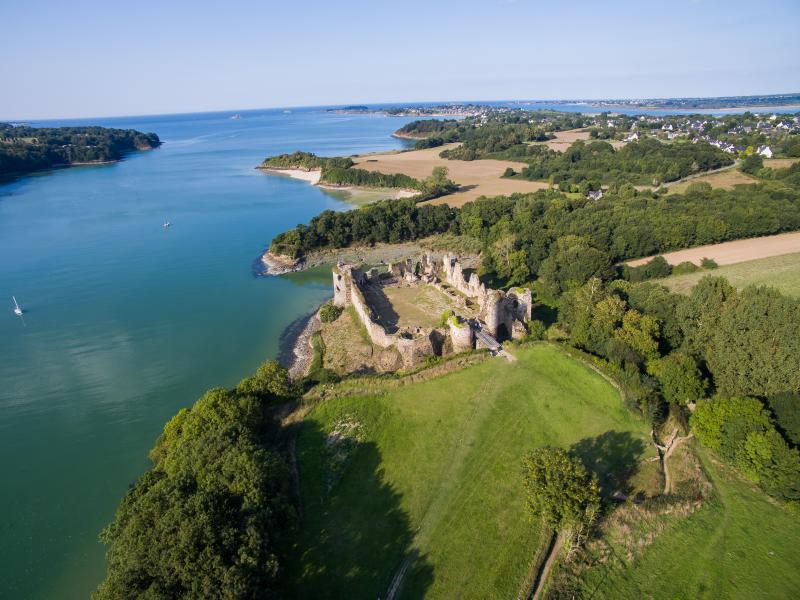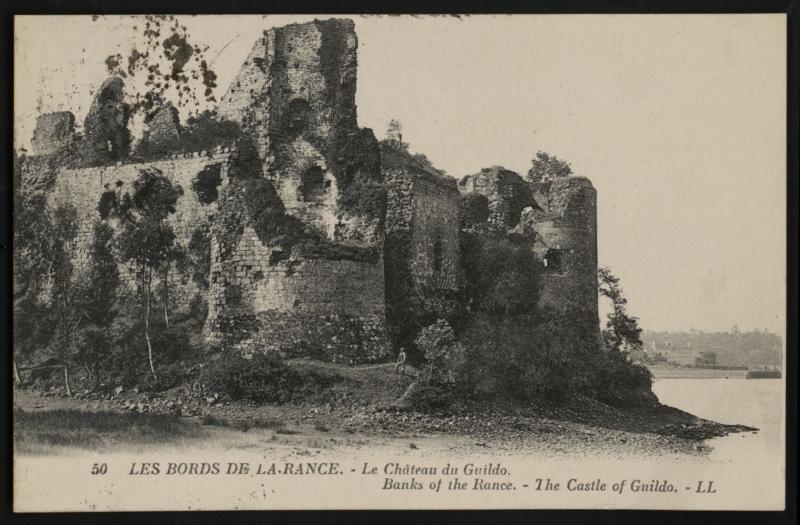
The Château du Guildo site has been occupied for many centuries.
Location
The Château du Guildo is located on a rocky spur on the edge of the Arguenon estuary. This stronghold offers a strategic defensive position. Its location allows both sea and land crossings to be controlled.

Its environment in the Middle Ages
Currently, forest cover is quite extensive compared to medieval times. In the Middle Ages, the height of the towers is much greater and the vegetation is less dense, there is more cultivated land. Rye, buckwheat, broad beans and hemp were grown. We know this thanks to studies of pollens in the soil. It is possible that a medieval garden, of which nothing remains, was located in front of the château. The wash-house on the edge of the salt meadow also dates from this period. However, this is not the case for the remains of the dovecote, which dates from after the French Revolution.
As early as the 11the century, the first construction is attested by the presence of defensive ditches and embankments, probably topped by a wooden palisade. At that time, buildings were mainly made of wood and earth. There are two distinct areas on the spur: a courtyard to the north with a seigneurial residence and stables, and a bailey to the south. Very few elements from this period survive on the site.
From the 13the century onwards, the site, like many others, underwent major modifications: it was razed and then rebuilt in stone. New defensive systems were put in place. The view was cleared to allow better surveillance of the site. Moats were dug. A quadrangular enclosure with cylindrical towers at the corners and a two-tower châtelet were built. A seigniorial dwelling of great architectural quality. It is richly decorated with stained glass windows, decorations and painted plasterwork. A chapel and other buildings are arranged around a courtyard, backing onto the curtain walls, and were certainly built by a high-ranking individual. In those days, only the upper nobility could afford to build such a stone castle.
In the mid-14th century, the first stone castle was destroyed during the War of the Breton Succession (1341-1364). This war took place at the same time as the 100 Years' War and the Black Death epidemic. It pitted the heirs to the Duchy of Brittany against each other. The site remained abandoned for some time.
It was not until the end of the 14the century that the château was reinvested, probably by Charles de Dinan. The castle was completely rebuilt on the ancient remains. Leaning against the western curtain wall, the outbuildings provided accommodation for the servants. The east wing, also known as the "keep", served as the seigneurial dwelling. Indeed, a castle keep can be used for residential purposes. The southwest tower was rebuilt in a polygonal shape. A great hall, kitchen, chapel and living quarters were also built. The courtyard was laid out in a single space, with a water well in the middle. It is this enclosure that is still present today.
The Château du Guildo reached its apogee in the mid-15th century. It now belongs to Françoise de Dinan. She was heiress to several great Breton families and married Gilles de Bretagne and then Guy XIV de Laval. Later, she also became Anne de Bretagne's governess. It was she who carried out numerous improvements and embellishments: a new grand hall, new spiral stair towers, embellishment of the outbuildings, creation of a blacksmith's shop and stables. This was the heyday of Château du Guildo. Françoise de Dinan remained Lady of Le Guildo until her death in 1499. The château passed into the hands of the Laval family, and then several successive owners, but the building never regained its former splendor.
At the end of the 15th century, the Franco-Bretonne war (1489-1491) resulted in the marriage of Anne of Brittany to the French King Charles VIII. This Breton defeat was the first step towards the annexation of Brittany in 1514. This war caused enormous damage to the château: the entrance châtelet, outbuildings, stable and forge were destroyed, the great hall was ruined, and the polygonal tower and dwelling were burnt down.
A slow reconstruction took place in the early 16th century. Part of the towers, curtain walls and entrance châtelet were rebuilt.
At the time of the League War (1588-1598), the château was once again re-defended. It adapted to developments in gunpowder artillery, for example by building a firing terrace. The War of the League was a war of religion between the Protestant King of France Henri IV and the Duke of Mercoeur, the Catholic governor of Brittany. It was during this period and as a result of numerous sieges that the château suffered its greatest damage.
The Le Guildo site, gradually abandoned from the 17th century onwards, was cultivated and used as a stone quarry until the early 20th century.

Contacts
Infos. pratiques
- Free access during the dayFreeGeneral public
